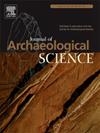黇鹿的丰度和年龄特征表明旧石器时代中期黎凡特存在机会主义狩猎
IF 2.5
1区 地球科学
Q1 ANTHROPOLOGY
引用次数: 0
摘要
旧石器时代先进的狩猎技能包括瞄准特定的猎物物种或壮年个体。美索不达米亚黇鹿(Dama mesopotamica)是黎凡特旧石器时代中期人类活动遗址中第二丰富的猎物物种,人们一直认为人类故意猎杀壮年个体。我们对地中海黎凡特地区旧石器时代中期洞穴遗址的黇鹿数量和年龄结构进行了区域分析。我们还对休鹿牙齿老化进行了改进和标准化,以应对现有方法之间关于壮年年龄边界的关键差异,这些差异会显著改变死亡率曲线的解释。我们的研究表明,使用磨损图,辅以特定磨损阶段的冠高测量,可以实现年龄队列的连贯分离。在此基础上,我们的研究结果表明,与人类和鬣狗的洞穴相比,自然陷阱中的黇鹿数量更多,而且无论积累因素如何,所有地点都具有非选择性的年龄结构,这证明了有意选择壮年黇鹿的说法是错误的。与此同时,与开放环境有关的物种,体型较小的瞪羚和体型大得多的欧洲野牛,似乎是首选的目标。这些证据表明,旧石器时代的猎人更喜欢开放的生物群落,并在前往指定狩猎场的途中抓住休闲鹿。我们认为,这种斑块选择模式可能是由于在非树木环境中寻找成本降低以及猎物物种的群居性和反掠食性行为。最终,我们证明了动物的大小并不是旧石器时代中期黎凡特南部人类选择猎物的主要决定因素。本文章由计算机程序翻译,如有差异,请以英文原文为准。
Fallow deer abundances and age profiles indicate opportunistic hunting in the Middle Paleolithic Levant
Advanced Paleolithic hunting skills have been suggested to include the targeting of specific prey species or prime-age individuals. The Mesopotamian fallow deer (Dama mesopotamica) was the second most abundant prey species in Levantine Middle Paleolithic anthropogenic sites, and it has been argued that humans deliberately hunted prime-aged individuals. We present a regional analysis of the fallow deer abundance and age structure at Middle Paleolithic cave sites in the Mediterranean zone of the Levant. We also refine and standardize fallow deer dental aging, responding to critical discrepancies between existing methods regarding the prime-old age boundary that change significantly the interpretation of mortality curves. Our study demonstrates that using wear diagrams, supplemented by crown height measurements for specific wear stages, enables coherent separation of age cohorts. Following that, our results show that fallow deer are more abundant in natural traps than human sites and hyena dens and that all sites, regardless of the agent of accumulation, possess an unselective age structure, disproving the claim for intentional selection of prime-aged fallow deer. At the same time, species associated with open environments, the smaller-bodied gazelle and much larger aurochs, seem to have been preferentially targeted. These lines of evidence suggest that Paleolithic hunters preferred open biomes and captured fallow deer opportunistically as they traveled to their designated hunting grounds. We suggest that this patch-choice pattern may be attributed to the reduced search costs in non-wooded environments and gregarious, anti-predatory behaviors of prey species. Ultimately, we demonstrate that animal size was not a primary determinant of human prey choice in the Middle Paleolithic southern Levant.
求助全文
通过发布文献求助,成功后即可免费获取论文全文。
去求助
来源期刊

Journal of Archaeological Science
地学-地球科学综合
CiteScore
6.10
自引率
7.10%
发文量
112
审稿时长
49 days
期刊介绍:
The Journal of Archaeological Science is aimed at archaeologists and scientists with particular interests in advancing the development and application of scientific techniques and methodologies to all areas of archaeology. This established monthly journal publishes focus articles, original research papers and major review articles, of wide archaeological significance. The journal provides an international forum for archaeologists and scientists from widely different scientific backgrounds who share a common interest in developing and applying scientific methods to inform major debates through improving the quality and reliability of scientific information derived from archaeological research.
 求助内容:
求助内容: 应助结果提醒方式:
应助结果提醒方式:


